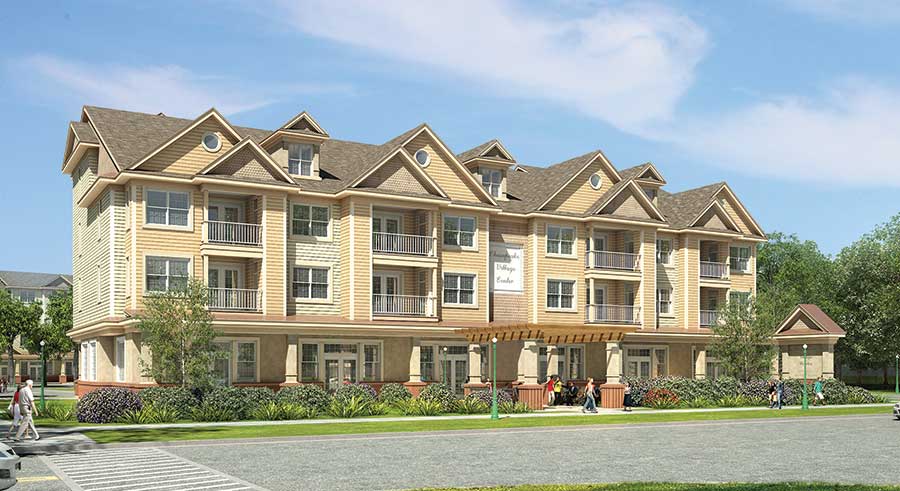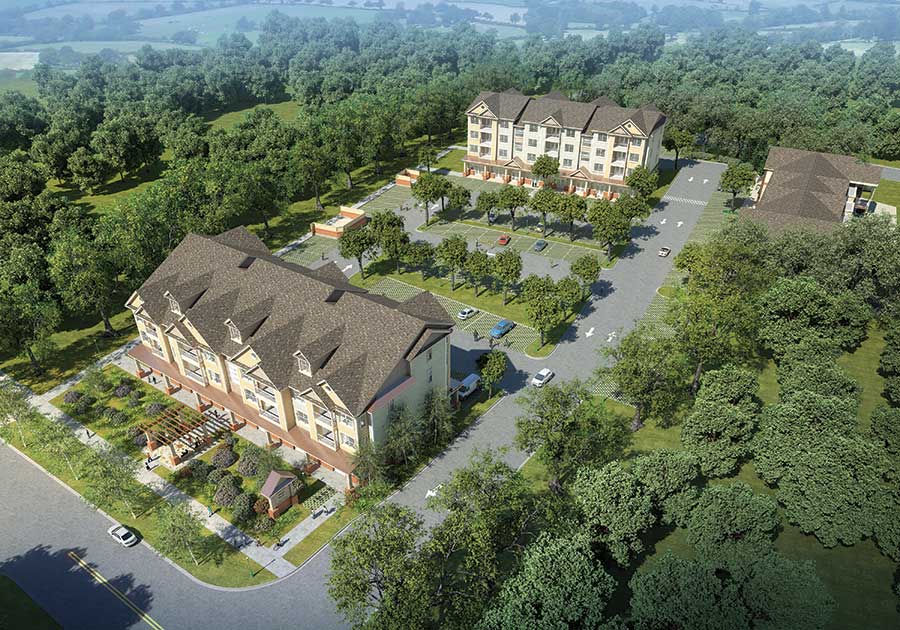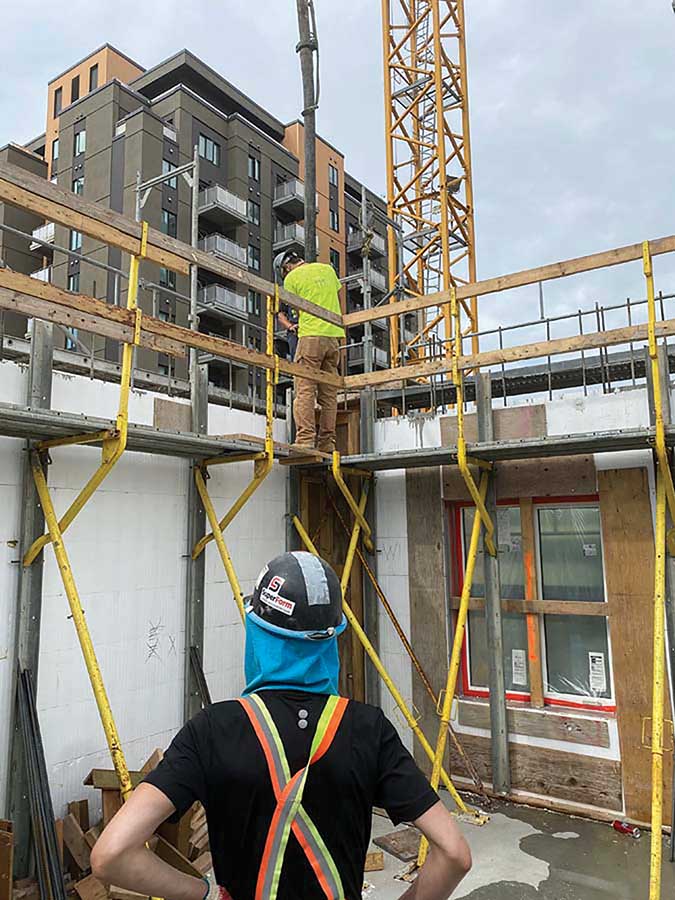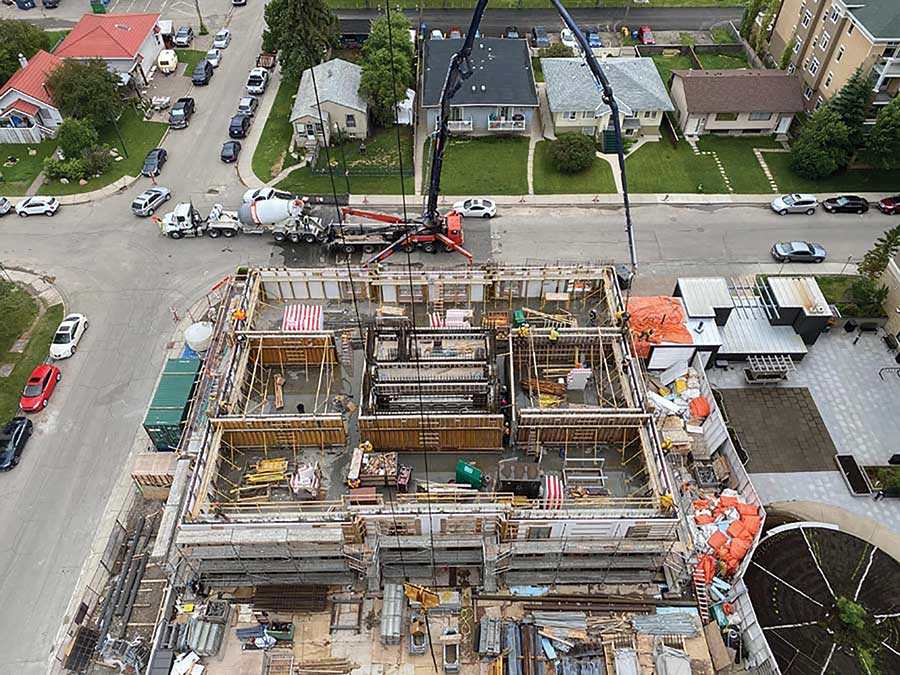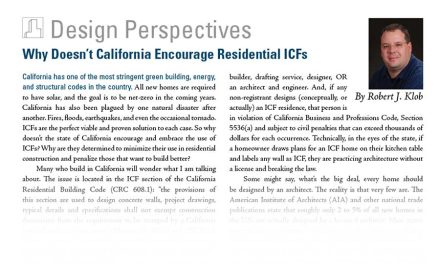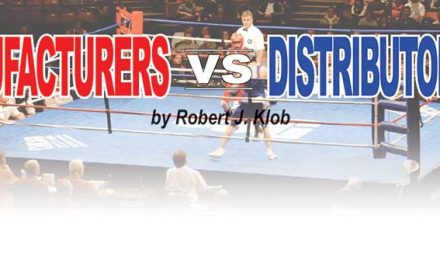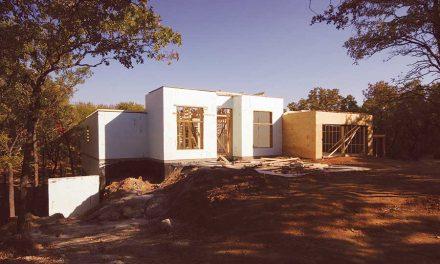Chesapeake Village Center in Stevensville, Maryland (shown here and on page 9), consists of two buildings ranging from 18,000 to 21,000 square feet. They are four stories of mixed use with commercial space on the first floor and apartment homes on the upper floors.
By Vanessa Salvia
There are a lot of benefits to using ICFs for residential construction. We’re talking benefits like speed of completion, strength, and sound attenuation. When you add up these characteristics and more, it only makes sense that the benefits would multiply for larger or more complex commercial projects. ICFs are strong, thanks to their reinforced concrete, and they are energy efficient, also thanks to the thermal mass of the concrete and the foam that the concrete is sandwiched into.
Any type of building can be built using ICFs, whether that is a theater, office building, retail store, high rise, hotel or apartment, healthcare facility, manufacturing facility, etc. The process of building a residential home is pretty much the same as building any type of ICF building, except the scale is different. First, the forms are placed. Then the rebar and concrete go into the forms. The forms remain in place, which provides a durable construction method.
Construction spending is a huge driver to the economy. Construction spending through November 2021 totaled $1.46 trillion, according to ConstructConnect. Even though non-residential starts fell over the past two years due to the pandemic, things should start increasing again. ConstructConnect predicts a 6.6% increase in 2022 to $1.67 trillion. Nonresidential construction should increase 5.6% to $837 billion in 2022. Dodge Data’s Construction Network says that during the first six months of 2022, the value of commercial and multifamily construction starts in the top 20 metropolitan areas of the U.S. increased 24% from 2021. This demand is largely driven by the need for apartments and condos. Dodge considers commercial and multifamily starts to be office buildings, stores, hotels, warehouses, commercial garages, and multifamily housing. They don’t include educational facilities, hospitals, convention centers, casinos, transportation terminals, manufacturing buildings, single family housing, public works, and electric utilities or gas plants.
Schools and theaters are a growing segment of commercial ICF construction thanks to their durability in the face of natural disasters and, in the case of theaters, their high sound attenuation. Schools built with ICFs are also becoming more popular due to their speed of construction and the fact that they are highly energy efficient (please see the September/ October 2022 issue of ICF Builder Magazine for more about schools built with ICFs.)
Dave Gowers is the principal of Dave Gowers Engineering LLC in Southern Oregon, offering structural engineering for ICF construction in the Northwest. He is also co-principal of Cascade ICF LLC, an iSPAN and Logix ICF distributor. Over the past 18 years, Gowers has produced structural design solutions for more than 150 ICF projects, both residential and commercial. “With the quality and price of alternate materials, it makes no sense to me to not consider ICF as the preferred material for commercial construction,” Gowers says. “Initial material cost is about the same, there is less demand for skilled labor, huge benefits of energy savings, and consequent reduced operating costs, to name just a few of the benefits.”
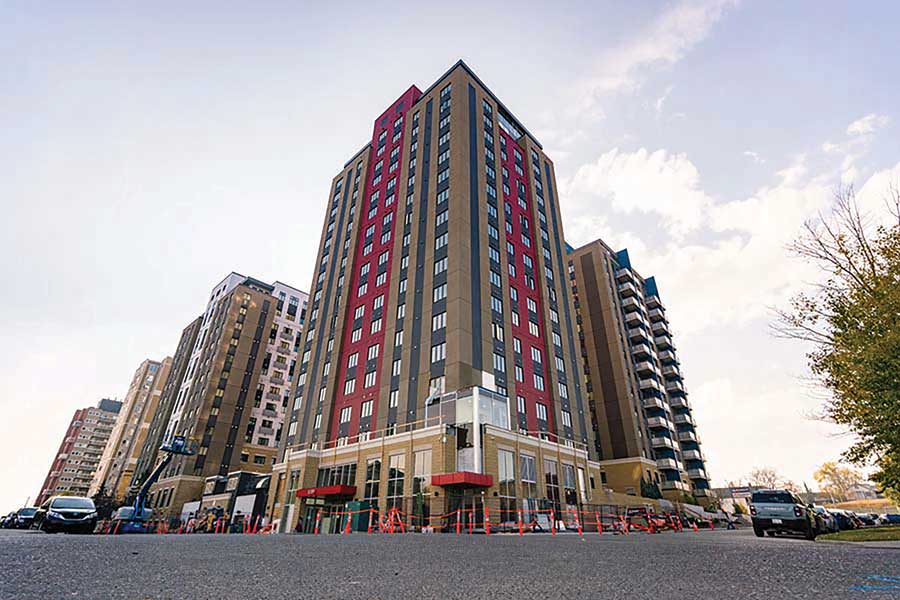
Orion at Lumino Park, constructed with SuperForm, is an 18-story highrise that received the Green Built platinum rating and uses 80% less energy than a traditional highrise. Photos courtesy of Superform
A Quiet Space & Other Benefits
Commercial buildings such as hotels, office buildings, and retail stores demand good sound attenuation. Building with ICFs not only helps maintain quiet between offices or tenants, but also keeps outside noise from entering the structure. This can mean your commercial building is quiet even if it is located on a busy street corner or near an airport or railroad. In entertainment applications like a theater, this sound-diminishing quality really pays off. Theater walls traditionally are thick to block out noise. Using ICFs allows the theater to have thinner walls so they can add more seats (and quieter walls) with the same amount of square footage.
David Azar is a developer, builder, real estate broker, and property manager in Maryland who has completed two ICF projects. He is the owner of the building company Eastern Bay Management Corporation. He also owns Chesapeake Village Center in Stevensville, Maryland. It is four stories of mixed-use with commercial space on the first floor and apartment homes on the upper floors, built with IntegraSpec. (Chesapeake Village Center was a 2020 finalist in the ICF Builder Awards in the MultiFamily category: www.icfmag.com/2020/11/chesapeake-village-center) His latest building is a mix of residential and commercial spaces that have been occupied for more than a year. He chose ICF partly because of sound attenuation. “When you mix residential with commercial applications the sound barriers with ICF are far superior to anything else,” Azar says.
He says his tenants didn’t understand the benefits of the ICF building when they signed up, partly because once the building is completed you can’t see the construction method. But when people walk by during construction, you have a chance to explain to them what they are seeing. Once people start using the building, though, testimonials roll in.
Efficiency of Construction
ICFs are a highly durable and efficient building method that can fulfill many purposes. They serve as a thermal barrier, air barrier, moisture barrier, fire barrier, sound barrier, pest barrier, and as a substrate for attaching finish materials. ICF’s make concrete walls even easier by the ability to add utility lines chased into the width of the EPS foam panels. Projects can continue through the coldest and hottest weather because the concrete stays at the right curing temperature thanks to ICF’s insulating properties.
Construction times with ICF are usually shorter, barring some unforeseen occurrence, meaning that projects can finish on time or early and on budget. This is because ICF blocks are stacked by hand directly onto the footings, with rebar placed into the forms. When you’re dealing with an office building or apartment, the owner can fill the building sooner, which means faster income to help offset your overall construction costs. It is also possible to panelize ICF walls off-site, which means an even greater construction speed. Once a building is occupied, Azar says you can begin to compile actual energy costs and use that to explain to other prospective tenants and to future developers.
Randy Daniels is the commercial business development advisor for the Western U.S. for Fox Blocks (Airlite Plastics Co.) He explains the efficiency based on the wall assemblies. “Multilayer wall assemblies are the lowest hanging fruit for getting someone to switch to ICF,” Daniels says. “Any mass wall design that also includes some furring and insulation and air moisture weather barriers and an exterior finish is slower to assemble versus ICF to the tune of 10-30+% It’s more costly on average 5 to 10%. And less performing in acoustics and thermal and structural risk reduction.”
ICF wall assemblies are superior because they’re solid cast in place concrete with more than five inches of rigid insulation. Daniels can quickly show folks who are “tire kicking” ICFs that other wall assemblies have more steps involved, therefore are slower. “From a purely business decision based on cost, schedule, and performance, with ICF you can get it built faster for less money, and it’s going to perform better,” Daniels says.
Saving Money
The insulating qualities of the thermal mass created within the EPS foam cavity results in a more consistent interior temperature. This means less air conditioning used on a hot day, and less heating used on a cold day. According to the National Ready Mix Concrete Association (NRMCA), energy savings with ICFs range from 20% to as much as 50%, especially when other energy-saving strategies are implemented.
Daniels says life cycle assessments show that most ICF envelopes deliver payback within 3 to 5 years, resulting in a more profitable building over time. For churches, schools, government or public safety buildings, hotels, apartment buildings, theaters, and the like that are intended to be in use for decades, ICF greatly reduces ongoing operational costs over time.
Strength and Safety Advantages
Concrete and the polystyrene foam it is sandwiched within are non-combustible. This means if a fire does start, it probably won’t spread. According to the NRMCA, all ICF manufacturers achieve a 2-hour fire rating with a 4-inch block, a 3- or 4-hour fire rating with a 6-inch block, and a 4-hour rating with 8-inch and thicker blocks. Studies and anecdotal evidence have repeatedly proven that reinforced concrete resists high wind better than any other construction material. Industry figures agree that the solid, reinforced concrete walls of ICF structures are estimated to be 10 times more durable than wood or cross-laminated timbers. Cinder blocks are sturdier than wood, but still can crack.
Concrete is resistant to wind, earthquakes, and fires. In some cases of high wind, a roof may be damaged but the structure itself remains undamaged. Likewise, if a building floods, the structure itself is still sturdy.
For Azar, the safety of the people living in and working in his buildings is vitally important.
“If you’re building with wood, yes, you have sprinkler systems and comply with fire code,” he says. “But at the end of the day, you still have wood that will burn. And with more than 100 people in one building at any given moment of any day, to me, life safety has to be ranked number one.”
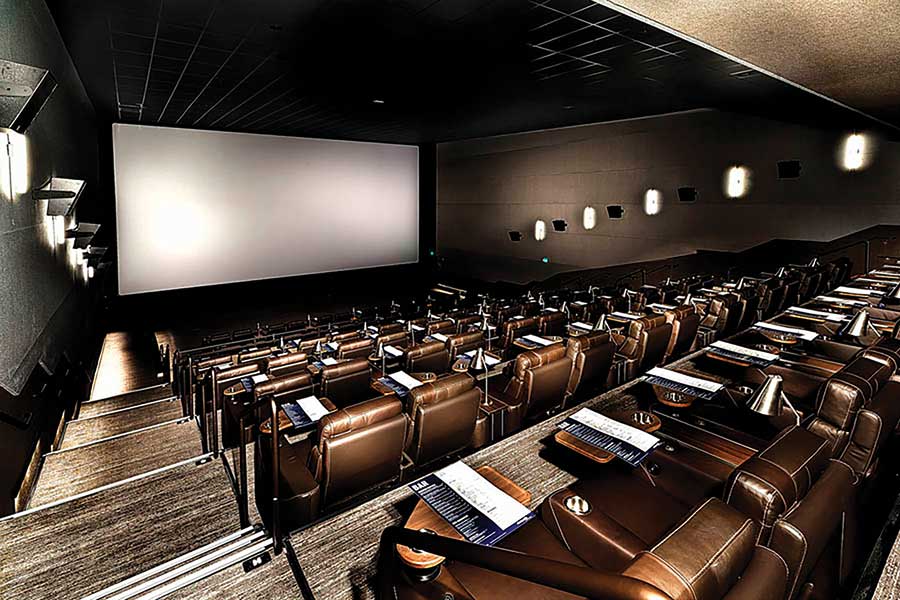
The Cinepolis La Costa Town Cinemas, built with Fox Blocks, is a great example of a theater taking advantage of ICF’s sound attenuation benefits. Photos courtesy of Fox Blocks
Industry Drawbacks
Even when faced with all of these advantages, we know that people don’t always choose ICF. Daniels says the explanation he hears most often is that people just aren’t familiar enough with it, so they revert to what they know. “The architect and structural engineer have stock designs ready for what they’ve always done,” he says. “And for them, it’s less time to draw a set of plans the way they’ve always done it. It appears as though ICF adds risk when actually it lowers risk, but if the GC is unfamiliar with it, they can’t make an informed decision. So then the owner is faced with an uphill battle trying to get ICF specified.”
Daniels stresses that all manufacturers have a multitude of detailed plans to show along with generous support for design teams. Another pushback is that light-frame construction continues to be a slightly lower cost than ICF.
For many people, including builders like Azar, there just aren’t enough builders trained to work with ICF to keep up with demand. But as the industry grows, there will be increasingly more ICF buildings and more evidence to share about how great they are. On Azar’s last project, he used two different subcontractors for the ICF portion and experienced problems to the point that he won’t work with that company again. “The negative part for me is finding quality workmanship and knowledge in my area,” he says. “I don’t have a scalable workforce. But that’s the only negative I can figure. Everything else to me, it’s just positive.”
Conclusion
ICF systems result in construction that is faster and easier than other construction methods. ICF construction eliminates the need for some subtrade work or skilled labor such as masons in the case of CMUs. ICF construction can continue all year-round with very little impact from freezing weather or high heat.

